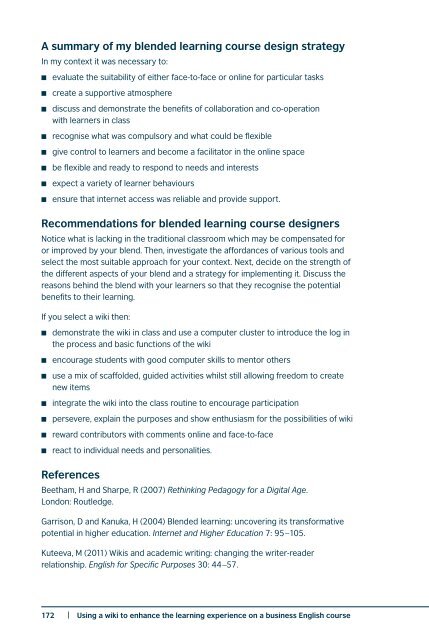Blended Learning in English Language Teaching: Course Design and Implementation
Blended Learning in English Language Teaching: Course Design and Implementation
Blended Learning in English Language Teaching: Course Design and Implementation
Create successful ePaper yourself
Turn your PDF publications into a flip-book with our unique Google optimized e-Paper software.
A summary of my blended learn<strong>in</strong>g course design strategy<br />
In my context it was necessary to:<br />
■■ evaluate the suitability of either face-to-face or onl<strong>in</strong>e for particular tasks<br />
■■ create a supportive atmosphere<br />
■■ discuss <strong>and</strong> demonstrate the benefits of collaboration <strong>and</strong> co-operation<br />
with learners <strong>in</strong> class<br />
■■ recognise what was compulsory <strong>and</strong> what could be flexible<br />
■■ give control to learners <strong>and</strong> become a facilitator <strong>in</strong> the onl<strong>in</strong>e space<br />
■■ be flexible <strong>and</strong> ready to respond to needs <strong>and</strong> <strong>in</strong>terests<br />
■■ expect a variety of learner behaviours<br />
■■ ensure that <strong>in</strong>ternet access was reliable <strong>and</strong> provide support.<br />
Recommendations for blended learn<strong>in</strong>g course designers<br />
Notice what is lack<strong>in</strong>g <strong>in</strong> the traditional classroom which may be compensated for<br />
or improved by your blend. Then, <strong>in</strong>vestigate the affordances of various tools <strong>and</strong><br />
select the most suitable approach for your context. Next, decide on the strength of<br />
the different aspects of your blend <strong>and</strong> a strategy for implement<strong>in</strong>g it. Discuss the<br />
reasons beh<strong>in</strong>d the blend with your learners so that they recognise the potential<br />
benefits to their learn<strong>in</strong>g.<br />
If you select a wiki then:<br />
■■ demonstrate the wiki <strong>in</strong> class <strong>and</strong> use a computer cluster to <strong>in</strong>troduce the log <strong>in</strong><br />
the process <strong>and</strong> basic functions of the wiki<br />
■■ encourage students with good computer skills to mentor others<br />
■■ use a mix of scaffolded, guided activities whilst still allow<strong>in</strong>g freedom to create<br />
new items<br />
■■ <strong>in</strong>tegrate the wiki <strong>in</strong>to the class rout<strong>in</strong>e to encourage participation<br />
■■ persevere, expla<strong>in</strong> the purposes <strong>and</strong> show enthusiasm for the possibilities of wiki<br />
■■ reward contributors with comments onl<strong>in</strong>e <strong>and</strong> face-to-face<br />
■■ react to <strong>in</strong>dividual needs <strong>and</strong> personalities.<br />
References<br />
Beetham, H <strong>and</strong> Sharpe, R (2007) Reth<strong>in</strong>k<strong>in</strong>g Pedagogy for a Digital Age.<br />
London: Routledge.<br />
Garrison, D <strong>and</strong> Kanuka, H (2004) <strong>Blended</strong> learn<strong>in</strong>g: uncover<strong>in</strong>g its transformative<br />
potential <strong>in</strong> higher education. Internet <strong>and</strong> Higher Education 7: 95 –105.<br />
Kuteeva, M (2011) Wikis <strong>and</strong> academic writ<strong>in</strong>g: chang<strong>in</strong>g the writer-reader<br />
relationship. <strong>English</strong> for Specific Purposes 30: 44 –57.<br />
172 | Us<strong>in</strong>g a wiki to enhance the learn<strong>in</strong>g experience on a bus<strong>in</strong>ess <strong>English</strong> course


